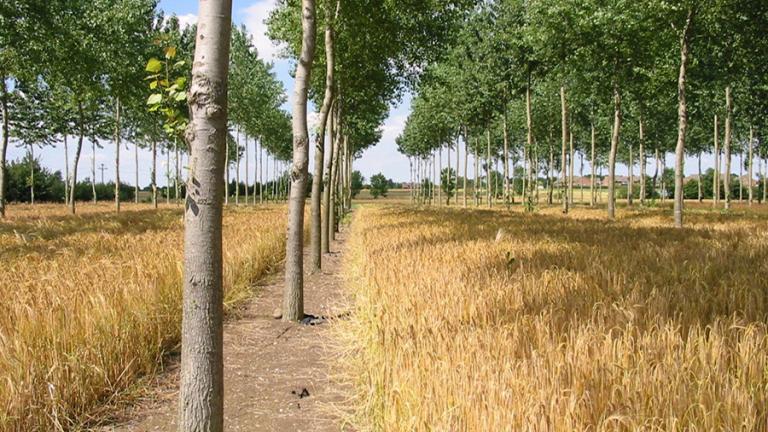
Case study of Italian farmland shows potential of agroforestry to sequester carbon
Mark Dwortzan | MIT Center for Sustainability Science and Strategy
Combining multiple activities on a single plot of land can be an effective strategy to reduce greenhouse gas emissions that drive climate change, whether in urban or rural settings.
In cities, planners can implement “smart growth” policies that concentrate residential and commercial buildings in compact, walkable city centers. This arrangement minimizes vehicle miles while maximizing green space that sequesters carbon, resulting in lower net greenhouse gas emissions. In rural areas, farmers might practice agroforestry, a nature-based climate mitigation solution that integrates the cultivation of trees with crops or livestock.
Trees, which remove carbon dioxide from the atmosphere and store it in their biomass and the soil, deliver durable and verifiable carbon sequestration while improving soil health, biodiversity, farm productivity, and other environmental conditions. But can trees sequester enough CO2 on farmland to make a notable difference in efforts to meet the long-term global climate goal of capping global warming at 1.5 degrees Celsius?
A new study in Scientific Reports projects that in Northern Italy, restoring silvoarable systems—a once-widespread agricultural practice in Europe that combines widely spaced trees with annual or perennial crops—could significantly enhance the region’s carbon sequestration capability. This finding suggests that the practice has the potential to likewise enhance carbon sequestration on farmland across the globe, resulting in a substantial reduction of agriculture’s carbon footprint.
Using land-use records and historical sources covering the past century, the study reconstructs the historical role of agroforestry in Northern Italy, where it had declined precipitously since the 1950s due to industrialization and modernization of agricultural practices. Based on Monte Carlo simulations and modeling of multiple plausible scenarios, researchers at the MIT Center for Sustainability Science and Strategy (CS3) and the University of Milan (Italy) estimate that historic silvoarable systems stored an average of 75.4 tons of carbon per hectare (10,000 square meters, or about 2.5 acres), but were largely replaced with monocultures—fields in which one crop is cultivated at a time. As monocultures expanded by 77 percent, silvoarable systems declined by 97 percent.
The study’s modeled projections suggest that restoring silvoarable systems could boost regional carbon sequestration by up to 12 percent, a gain comparable to afforestation strategies that would require converting 25 percent of existing farmland to new forest land.
“Our findings illustrate the value of traditional ecological knowledge and historical land-use strategies in informing carbon-smart agricultural transitions and the design of policies for resilient, multifunctional landscapes,” says Filippo Brandolini, a Marie Skłodowska-Curie postdoctoral fellow at CS3 and the study’s lead author. “The results from Northern Italy provide crucial insights for Europe and beyond. Today, agroforestry remains vital in many tropical regions, but its revival in temperate areas could be a real game changer for carbon-smart agriculture worldwide.”
As a next step, the researchers are incorporating agroforestry systems in CS3’s socio-economic model (EPPA) to evaluate their economic feasibility in today’s European market.
“Modeling agroforestry systems in our socio-economic framework will allow us to assess the economic incentives needed to persuade farmers to transition from monoculture to agroforestry,” says Brandolini, who is leading a project aimed at guiding decision-makers on agroforestry policy and market strategies.






